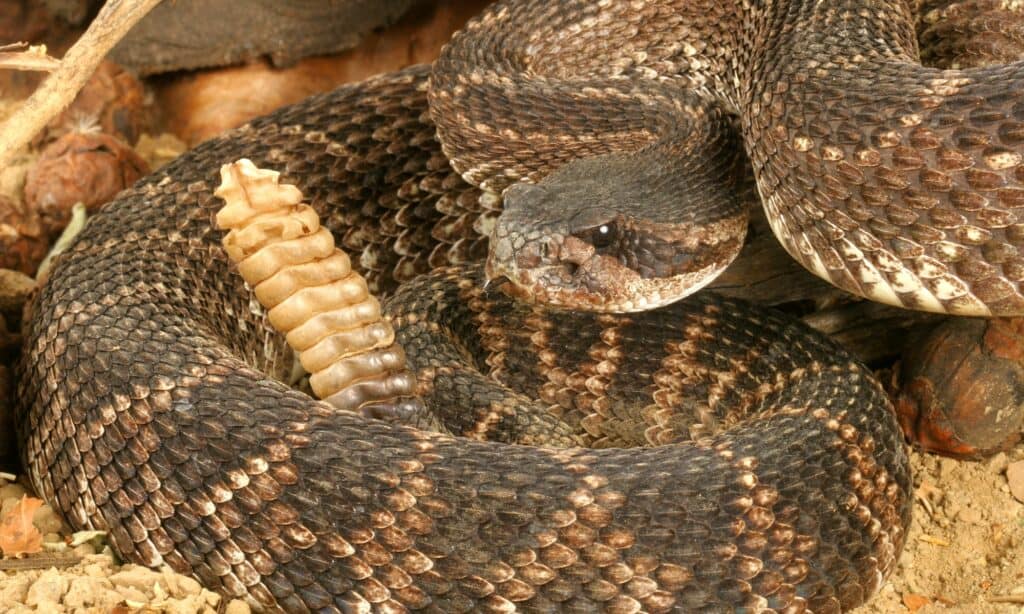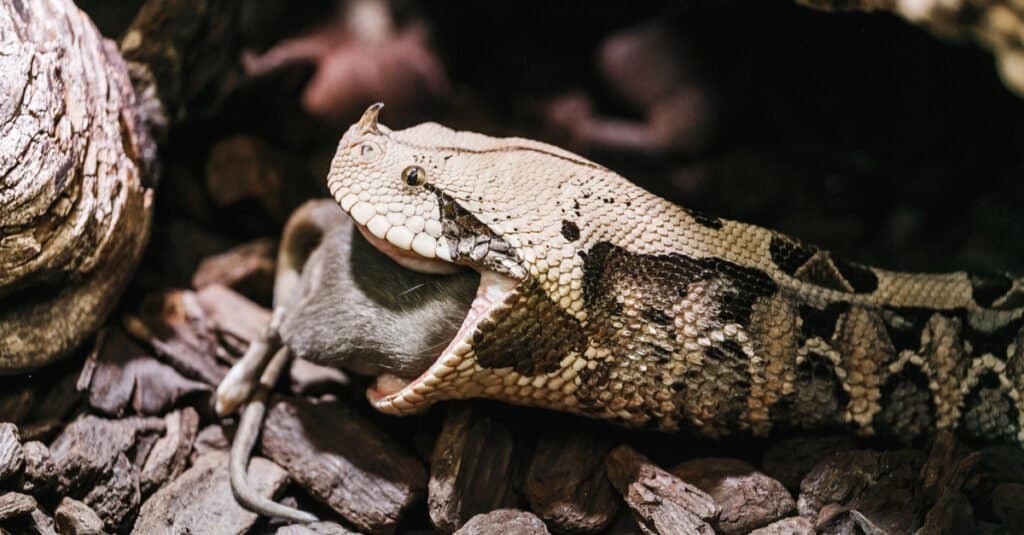Key Points
- The Gaboon viper and the rattlesnake are both considered vipers, a certain family of snakes.
- The two snakes differ primarily in location and morphology.
- Rattlesnakes and Gaboon vipers are both venomous snakes and their bites can be fatal to humans.
Both the Gaboon viper and the rattlesnake belong to the Viperidae family of snakes. That’s just about where the similarities between these two reptiles end. Today, we will compare and contrast the Gaboon viper vs rattlesnake and show you what they have in common and what’s different. By the time we’re finished, you’ll never confuse these snakes for one another.
Comparing a Gaboon Viper and a Rattlesnake

| Gaboon Viper | Rattlesnake | |
|---|---|---|
| Size | Weight: 20lbs-45lbs Length: 4ft-7ft | Weight: 5lbs-10lbs Length: 1.5ft-8ft, with extremes at either end depending on the species |
| Venom | – Delivers massive amounts of venom because it doesn’t release after biting – Cytotoxic venom that is not highly toxic but enhanced due to volume – Delivers between 200 and 600mg of venom per bite – Capable of killing roughly 6 people with a single bite | – May inject as little as 6.5mg to 10mg – Envenomates in 60%-80% of all bites, so there is a fair chance of a dry bite – Strong hemotoxic venom in most cases, causing necrosis and disrupting blood clotting – Some Mojave rattlesnakes and tiger rattlesnakes have a neurotoxin |
| Fangs | – 2.2in length, the longest of any venomous snake – Hinged front fangs Bites and hangs on to deliver more venom | – Hinged fangs – Bites and releases – Fangs can measure up to 0.75in or slightly more |
| Morphology | – Broad, Leaf-shaped head – Horns between nostrils – Body can measure 6in across in places – Colors include brown, grey, purple, and yellow – Easily blends in with the forest floor | – Triangular head – Thick bodied – Rattle on the end of their tail – Several distinct patterns, such as the diamondbacks – Heat-sensing pits – Colors vary, including brown, olive, muted yellows, and even brighter colors like orange in some cases |
| Location | – Sub-Saharan Africa in warm, moist areas like rainforests | – Throughout the Americas, from Canada to Argentina, most common in the southwest U.S., where most species are found. |
The Key Differences Between a Gaboon Viper vs Rattlesnake

Rattlesnakes vary in size, length, and venom toxicity.
©iStock.com/johnaudrey
The greatest differences between a Gaboon viper and a rattlesnake are their morphology and location. Gaboon vipers are venomous snakes in sub-Saharan Africa, known for their broad, leaf-shaped head, horns between their nostrils, and thick, heavy bodies. Rattlesnakes are endemic to the Americas, possess a triangular head, have a thick body, and have a distinct rattle on the end of their tail that is used as a defensive warning.
These differences make the snakes distinct, but many other differences exist between them. We’ll show you some of the most significant ways that these snakes differ from one another.
Gaboon Viper vs Rattlesnake: Size
Gaboon vipers are larger than rattlesnakes on average. They typically weigh between 20lbs and 45lbs and grow up to 7ft long. These snakes are thick-bodied and can measure up to 6 inches across at some points on their bodies.
Rattlesnakes vary in size, weighing between 5lbs and 10lbs on average and measuring 1.5ft to 6ft long. The pygmy rattlesnake is exceptionally small, weighing under 1lb and measuring 1-2ft. However, the largest rattlesnake ever measured almost 8ft long and weighed 34lbs!
Overall, Gaboon vipers are larger on average than rattlesnakes.
Gaboon Viper vs Rattlesnake: Venom
Gaboon vipers inject a massive amount of venom into people, delivering enough venom to kill six humans. A Gaboon viper’s venom is cytotoxic, and a rattlesnake’s venom is mostly hemotoxic. A notable exception exists in some Mojave rattlesnake and tiger rattlesnakes, both of which have neurotoxic venom that makes their bite especially dangerous.
Gaboon vipers deliver upwards of 600mg of venom per bite and carry 2,400mg of venom in their glands. They bite and hang on, delivering as much venom as possible to overwhelm their prey. Rattlesnakes may use dry bites to scare potential prey, but they also inject between 6.5mg-8.5mg of venom when they do bite.
Both snakes possess venom strong enough to kill a human being, but they differ in their compositions and delivery.
Gaboon Viper vs Rattlesnake: Fangs

Western diamondback rattlesnakes have retractable fangs that they replace when they break.
©Audrey Snider-Bell/Shutterstock.com
Both Gaboon vipers and rattlesnakes have hinged front fangs that shift forward when the snake bites. Rattlesnake fangs measure about 0.75in or up to 1in long, but Gaboon vipers have the longest fangs of any venomous snakes at 2in or a little longer.
Interestingly, Gaboon vipers do not bite and release their prey like other venomous snakes despite having a very fast strike. Instead, they will bite and sink their fangs into their prey to deliver as much venom as possible. Rattlesnakes will bite and release their prey, allowing their venom to do its work.
Gaboon Viper vs Rattlesnake: Morphology
Rattlesnakes are known for their triangular heads, thick bodies, and the rattles at the end of their tails. These rattles grow every time the snake sheds and are used as part of a threat display to get animals to back away from them before a bite. Rattlesnakes come in many colors, but they are often brown, black, olive, muted yellows, and more. Lastly, rattlesnakes are pit vipers that have heat-sensing organs between their eyes and nostrils.
Gaboon vipers have broad heads that are often described as leaf-shaped. They also have two horns above their nostrils. Their bodies can be very thick, sometimes measuring about 6 inches across in places. These snakes integrate brown, gray, purple, and yellow into the color scheme, and they can blend in well with the forest floor.
Gaboon Viper vs Rattlesnake: Location
Rattlesnakes are found in the Americas, from Canada through the southern portions of South America. They are found in many states in the U.S., and Arizona is known for being the state with the most types of rattlesnakes!
However, the Gaboon viper is found in the sub-Saharan area of Africa, especially in rainforests and other warm, humid, moist places. These snakes aren’t widely distributed in areas where many people live, so encounters with them are somewhat rare.
Gaboon Viper vs Rattlesnake: Temperament

Gaboon vipers are the heaviest venomous snake on the African continent.
©frantic00/Shutterstock.com
Rattlesnakes are often considered aggressive, but that’s not precisely true. They are defensive if something gets too close to them, but they aren’t going to chase you down and bite you. If you happen across a rattlesnake, it will assume a defensive stance, rattle, and strike if you get close.
Gaboon vipers are said to be lethargic and rather docile. That doesn’t mean humans have any business handling them in the wild. They can kill humans, after all. These snakes will hiss if someone gets too close, but they often depend on their camouflage to act as their primary defense.
All in all, the Gaboon viper and rattlesnakes are very different creatures. Both are deadly and use roughly the same means to attack, but they look and act in unique manners. The best practice is to avoid both of these snakes in the wild.
Snakes as Pets
Ultimately snakes can make pretty good pets, as many species are docile and require minimal upkeep. However, venomous snakes of any species, especially Gaboon vipers and rattlesnakes, do not make good pets and should not be held in captivity. These snakes are unpredictable, territorial, and deadly to humans and other animals.
If choosing a snake as a pet, make sure you know the temperament, living conditions, feeding, and other information prior to acquiring one.
Up Next…
Snake species can be hard to tell apart, especially if they resemble each other or share similar habitats. Check out some more serpent comparisons to help bolster your snake knowledge:
- Rattlesnake Vs Anaconda: How Are They Different? – Venomous and non-venomous, both snakes are dangerous. Find out how.
- Rattlesnake Vs Puff Adder: How Are They Different? – Seemingly similar, how are these snakes truly different?
- Gaboon Viper vs Black Mamba: What Are the Differences? – Both deadly, see the main differences in these venomous snakes.
The photo featured at the top of this post is © Danita Delimont/Shutterstock.com
Discover the "Monster" Snake 5X Bigger than an Anaconda
Every day A-Z Animals sends out some of the most incredible facts in the world from our free newsletter. Want to discover the 10 most beautiful snakes in the world, a "snake island" where you're never more than 3 feet from danger, or a "monster" snake 5X larger than an anaconda? Then sign up right now and you'll start receiving our daily newsletter absolutely free.
Thank you for reading! Have some feedback for us? Contact the AZ Animals editorial team.






